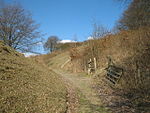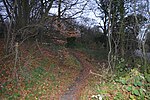Dunstable Downs

Dunstable Downs are part of the Chiltern Hills, in southern Bedfordshire in England, located near (and named after) the town of Dunstable. They are a chalk escarpment forming the north-eastern reaches of the Chilterns. At 243 m (797 ft), Dunstable Downs are the highest point in the county of Bedfordshire.Because of its elevation, Dunstable Downs hosted a station in the shutter telegraph chain which connected the Admiralty in London to its naval ships in the port of Great Yarmouth during the years 1808 to 1814.Whipsnade Zoo has cut an enormous lion shape into the chalk on the side of one of the hills. The lion can be seen from the B489 (Aylesbury to Dunstable road). The downs are used by gliders, kite fliers, hang gliders and paragliders in the area because of their height. The London Gliding Club is based at the foot of the downs. Much of the downs is managed by the National Trust as part of the Dunstable Downs & Whipsnade Estate property.
Excerpt from the Wikipedia article Dunstable Downs (License: CC BY-SA 3.0, Authors, Images).Dunstable Downs
Whipsnade Road,
Geographical coordinates (GPS) Address Nearby Places Show on map
Geographical coordinates (GPS)
| Latitude | Longitude |
|---|---|
| N 51.864243 ° | E -0.536344 ° |
Address
Whipsnade Road
Whipsnade Road
LU6 2GY
England, United Kingdom
Open on Google Maps









